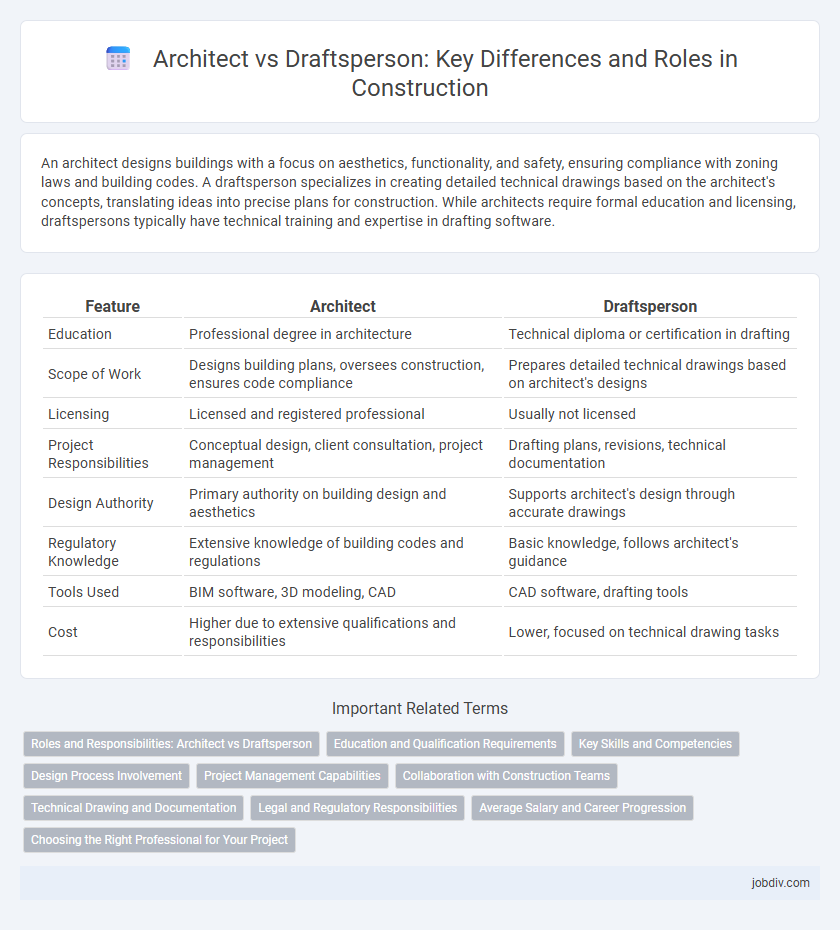An architect designs buildings with a focus on aesthetics, functionality, and safety, ensuring compliance with zoning laws and building codes. A draftsperson specializes in creating detailed technical drawings based on the architect's concepts, translating ideas into precise plans for construction. While architects require formal education and licensing, draftspersons typically have technical training and expertise in drafting software.
Table of Comparison
| Feature | Architect | Draftsperson |
|---|---|---|
| Education | Professional degree in architecture | Technical diploma or certification in drafting |
| Scope of Work | Designs building plans, oversees construction, ensures code compliance | Prepares detailed technical drawings based on architect's designs |
| Licensing | Licensed and registered professional | Usually not licensed |
| Project Responsibilities | Conceptual design, client consultation, project management | Drafting plans, revisions, technical documentation |
| Design Authority | Primary authority on building design and aesthetics | Supports architect's design through accurate drawings |
| Regulatory Knowledge | Extensive knowledge of building codes and regulations | Basic knowledge, follows architect's guidance |
| Tools Used | BIM software, 3D modeling, CAD | CAD software, drafting tools |
| Cost | Higher due to extensive qualifications and responsibilities | Lower, focused on technical drawing tasks |
Roles and Responsibilities: Architect vs Draftsperson
Architects are responsible for designing building concepts, ensuring structural integrity, functionality, and aesthetic appeal while complying with legal codes and client requirements. Draftspersons translate architects' designs into detailed technical drawings and blueprints needed for construction, focusing on precision and clarity. Architects lead project planning and decision-making, whereas draftspersons support by producing accurate documentation and visual representations.
Education and Qualification Requirements
Architects typically require a professional degree in architecture, such as a Bachelor or Master of Architecture, followed by completion of an internship and successful passing of the Architect Registration Examination (ARE) for licensure. Draftspersons usually hold a diploma or certificate in drafting or CAD (Computer-Aided Design) technology, with less stringent educational prerequisites and no formal licensing requirements. The extensive education and licensure for architects qualify them for design leadership and project management roles, whereas draftspersons focus on technical drawing and plan development under architectural supervision.
Key Skills and Competencies
Architects possess advanced design expertise, project management skills, and knowledge of building codes, enabling them to create innovative, functional structures while overseeing entire construction projects. Draftspersons specialize in technical drawing, precision, and CAD software proficiency, translating architectural ideas into detailed plans for builders and contractors. Both roles require strong spatial awareness and attention to detail, but Architects typically engage in conceptual design and client collaboration, whereas Draftspersons focus on executing technical documentation.
Design Process Involvement
Architects lead the design process by creating comprehensive building plans, ensuring compliance with regulations, and integrating aesthetics with functionality. Draftspersons specialize in producing precise technical drawings based on the architect's concepts, focusing on details required for construction documentation. The collaborative workflow between architects and draftspersons optimizes project accuracy and efficiency throughout the construction design phase.
Project Management Capabilities
Architects possess comprehensive project management capabilities, overseeing design development, regulatory compliance, and coordination with multiple stakeholders to ensure the project's vision is realized effectively. Draftspersones typically focus on creating detailed technical drawings and may have limited involvement in broader project management tasks such as budgeting, scheduling, and client communication. Effective project management in construction relies on the architect's ability to integrate design intent with execution logistics, while draftspersones support by providing precise documentation essential for project implementation.
Collaboration with Construction Teams
Architects lead design vision and specifications, ensuring compliance with regulations and aesthetic goals, while draftspersons translate those designs into precise technical drawings. Effective collaboration between architects and draftspersons streamlines communication with construction teams, reducing errors and facilitating project timelines. This synergy enhances coordination on-site, promoting accurate implementation of design intent and efficient problem-solving.
Technical Drawing and Documentation
Architects create comprehensive technical drawings and documentation that integrate design intent, structural elements, and building codes to ensure project feasibility and compliance. Draftspersons produce detailed and precise technical drawings based on the architect's specifications, focusing on accuracy and clarity for construction implementation. Both roles require mastery in CAD software and a deep understanding of construction standards to facilitate seamless project execution.
Legal and Regulatory Responsibilities
Architects hold legal responsibility for compliance with building codes, zoning laws, and safety regulations throughout the design and construction process, often requiring licensure and adherence to professional standards. Draftspersons primarily produce technical drawings under an architect's supervision and typically do not carry the same legal accountability for regulatory compliance. Architects are also responsible for obtaining permits and ensuring the project meets all statutory requirements before construction begins.
Average Salary and Career Progression
Architects typically earn an average salary ranging from $70,000 to $105,000 annually, reflecting their comprehensive education and licensure requirements, while draftspersons usually earn between $45,000 and $65,000. Career progression for architects often leads to senior design roles, project management, or starting their own firms, leveraging advanced skills and certifications. Draftspersons advance by specializing in areas such as 3D modeling or BIM technology, potentially transitioning into architectural technologist or junior architect positions.
Choosing the Right Professional for Your Project
Selecting the right professional for your construction project hinges on the complexity and scope of your design needs. Architects provide comprehensive services including conceptual design, regulatory approvals, and project oversight, ideal for large-scale or custom builds requiring innovative solutions. Draftspersons excel in producing detailed technical drawings and plans, making them suitable for straightforward projects or when working under an architect's guidance.
Architect vs Draftsperson Infographic

 jobdiv.com
jobdiv.com